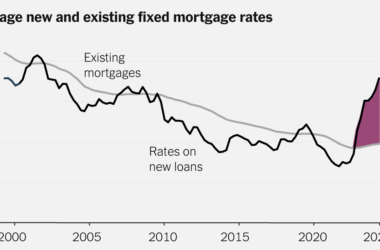The Supreme Court rejected a challenge on Thursday to the way the Consumer Financial Protection Bureau is funded, one that could have hobbled the bureau and advanced a central goal of the conservative legal movement: limiting the power of independent agencies.
The vote was 7 to 2, with Justice Clarence Thomas writing the majority opinion.
Had the bureau lost, the court’s ruling might have cast doubt on every regulation and enforcement action it had taken in its 13 years of existence, including ones concerning mortgages, credit cards, consumer loans and banking.
The central question in the case was whether the way Congress chose to fund the bureau had violated the appropriations clause of the Constitution, which says that “no money shall be drawn from the Treasury, but in consequence of appropriations made by law.”
Justice Thomas said the mechanism was constitutional.
“Under the appropriations clause,” he wrote, “an appropriation is simply a law that authorizes expenditures from a specified source of public money for designated purposes. The statute that provides the bureau’s funding meets these requirements. We therefore conclude that the bureau’s funding mechanism does not violate the appropriations clause.”
Justice Samuel A. Alito Jr., joined by Justice Neil M. Gorsuch, dissented.
The agency, which has faced sustained legal attacks, welcomed the decision.
“For years, lawbreaking companies and Wall Street lobbyists have been scheming to defund essential consumer protection enforcement,” said Sam Gilford, a spokesman. “The Supreme Court has rejected their radical theory that would have devastated the American financial markets.”
Critics of the agency called the ruling a missed opportunity. “This decision marks an alarming failure by the court to police the proper exercise of Congress’s constitutional powers,” said Dan Greenberg, the general counsel of the Competitive Enterprise Institute, a free-market public policy organization.
The bureau, created after the financial crisis as part of the 2010 Dodd-Frank Act, is not funded by an annual appropriation but rather through an unusual arrangement in which it draws resources, up to an annual cap, from the Federal Reserve system. That system, in turn, does not receive congressional appropriations but is financed by interest on securities it holds, gains from securities transactions and various fees.
The bureau, which was set up to ensure that consumers were not taken advantage of by credit card companies, debt collectors and other financial firms, has long been the subject of complaints from Republicans and business groups that it enjoys unchecked power.
Justice Thomas wrote that the question in the case was a narrow one and that “an identified source and purpose are all that is required for a valid appropriation,” surveying historical analogies from English, colonial and early American history.
In a concurring opinion, Justice Elena Kagan, joined by Justices Sonia Sotomayor, Brett M. Kavanaugh and Amy Coney Barrett, added that more recent history also supported the agency.
“The way our government has actually worked, over our entire experience, thus provides another reason to uphold Congress’s decision about how to fund the C.F.P.B.,” Justice Kagan wrote.
In her own concurrence, Justice Ketanji Brown Jackson wrote that the court should not “undercut the considered judgments of a coordinate branch about how to respond to a pressing national concern.”
In dissent, Justice Alito wrote that “the framers would be shocked, even horrified, by this scheme.”
“In sum,” he added, “the C.F.P.B.’s unprecedented combination of funding features affords it the very kind of financial independence that the appropriations clause was designed to prevent. It is not an exaggeration to say that the C.F.P.B. enjoys a degree of financial autonomy that a Stuart king would envy.”
A unanimous three-judge panel of the U.S. Court of Appeals for the Fifth Circuit, in New Orleans, ruled in 2022 that the bureau’s funding method ran afoul of the appropriations clause.
“Wherever the line between a constitutionally and unconstitutionally funded agency may be, this unprecedented arrangement crosses it,” Judge Cory T. Wilson wrote in an opinion joined by Judges Don R. Willett and Kurt D. Engelhardt in the ruling. President Donald J. Trump appointed all three judges.
The Fifth Circuit’s decision was at odds with ones from other courts. In 2018, for instance, the District of Columbia Circuit said there was nothing unusual about the funding mechanism.
In 2020, the Supreme Court ruled that a different part of the law creating the consumer bureau was unconstitutional, saying that Congress could not insulate the bureau’s director from presidential oversight given the scope of the job’s authority.
“The director has the sole responsibility to administer 19 separate consumer-protection statutes that cover everything from credit cards and car payments to mortgages and student loans,” Chief Justice John G. Roberts Jr. wrote for the majority.
He mentioned the bureau’s funding in passing, noting that its budget had exceeded half a billion dollars in recent years.
“Unlike most other agencies,” the chief justice wrote, “the C.F.P.B. does not rely on the annual appropriations process for funding. Instead, the C.F.P.B. receives funding directly from the Federal Reserve, which is itself funded outside the appropriations process through bank assessments.”
The case, Consumer Financial Protection Bureau v. Community Financial Services Association of America, No. 22-448, was brought by two trade groups representing payday lenders. They challenged a regulation limiting the number of times lenders can try to withdraw funds from borrowers’ bank accounts. The Fifth Circuit struck down the regulation, saying it was “wholly drawn through the agency’s unconstitutional funding scheme.”
In the coming weeks, the court is expected to rule on two other major challenges to agency power. One concerns the Chevron doctrine, which requires courts to defer to agencies’ reasonable interpretations of ambiguous statutes. The other is a challenge to the constitutionality of the Securities and Exchange Commission’s administrative tribunals.






